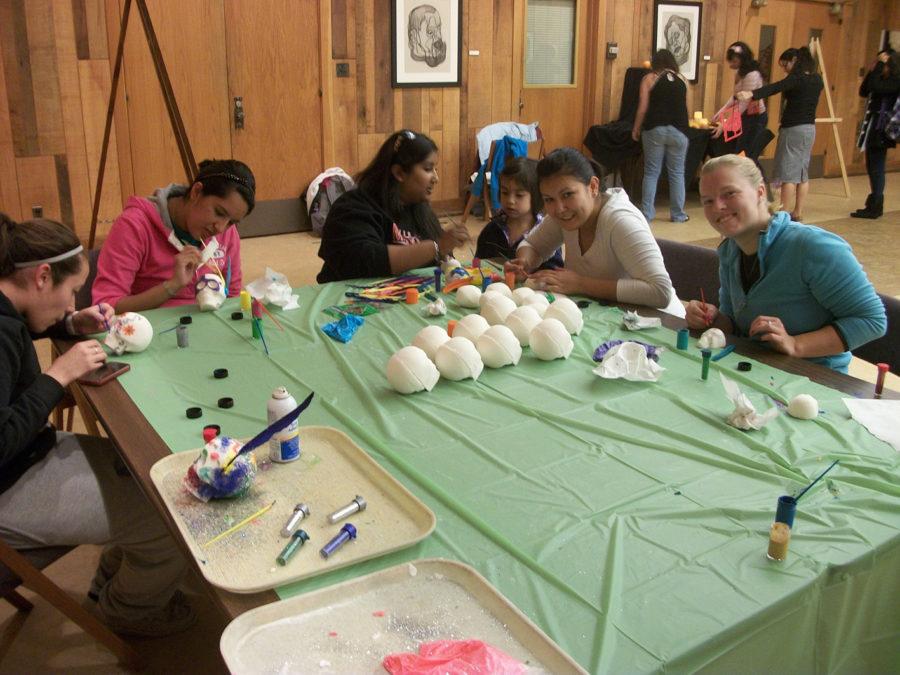Campus groups celebrate Day of the Dead, honor loved ones
Photo courtesy of Julio Ramirez
Before Thursday’s Dia de los Muertos celebration, Mexican-American Young Achievers Society members decorate sugar skulls Oct. 20 in the Memorial Union’s Pioneer Room. They called this event Noche de Artesanias, which means “Night of the Artisans” in English.
October 30, 2011
The Day of the Dead — known in Spanish-speaking countries as “El Dia de Los Muertos” — won’t fall until Wednesday, but Iowa State’s Mexican-American Young Achievers Society began celebrating it last week.
Erecting a cardboard altar Thursday night in the Memorial Union’s Pioneer Room, members of the group adorned it with candles, paper flowers and pictures of dead loved ones.
MAYAS Events Coordinator Roberto Orozco, senior in marketing, said scheduling difficulties prompted the early celebration.
“There’s no place on campus that we could leave the altar up for a long period of time,” Orozco said.
Pearson Hall’s Language Studies Resource Center will be the site of another small altar. Assistant professor of Spanish Elisa Rizo said it would be open to public view in the center by late Monday afternoon.
Just as campus groups do, other celebrators of Dia de los Muertos have long adapted their observances to suit circumstance. The form of it now celebrated in Mexico developed after the Spanish encountered the Aztecs there in the 16th century.
Over time, the two cultures fused traditions of All Souls’ Day, a Catholic observance that honors the dead, with those of similarly purposed Aztec rituals.
Brian Eslinger, lecturer of religious studies, said indigenous rituals “meant too much to the people to be totally dissolved” upon the arrival of the Spaniards.
“To have as many of the indigenous characteristics dominate what that ritual looks like tells you something about the strength of that ritual,” he said.
Native influence survives not only in the conduct of rituals, but also in the attitude celebrators take toward death.
Loreto Prieto, Iowa State’s director of U.S. Latino Studies, said that the “solemn umbrella of grief” that hangs over other cultures’ commemorations of the dead does not hang heavily over those who celebrate the festival. Most believe, as the Aztecs did, that the dead retain a link to this world.
Some believe their spirits return to earth to mingle with the living — even going so far as to revisit their former homes.
In this context, otherworldly visitations are rarely seen as disturbing or intrusive, as they might be elsewhere.
“This is a celebration,” Prieto said. “It’s not a scary thing at all to welcome someone who’s passed back into the home.”
Hector Avalos, professor of religious studies, noted the tone of levity that inflects celebrations of Dia de los Muertos — a tone he said it shared with holidays like Halloween.
“There’s the idea of making fun of death,” Avalos said.
The celebration’s light tone also manifests in some of the offerings people place on altars, which can symbolize more than just the virtues of the departed.
“You’ll have the skeleton figure that will represent their vices,” Eslinger said. “You’ll have the cigarettes and beer cans.”
Eslinger, Prieto and Avalos all thought it apt that a festival celebrating the dead coincided with the fall season’s end.
“There’s that reality of scarcity that’s just on the horizon,” Eslinger said. “And it’s at that time that you take stock.”
Avalos described the observance in more succinct terms: “It kind of symbolizes what’s coming next.”







